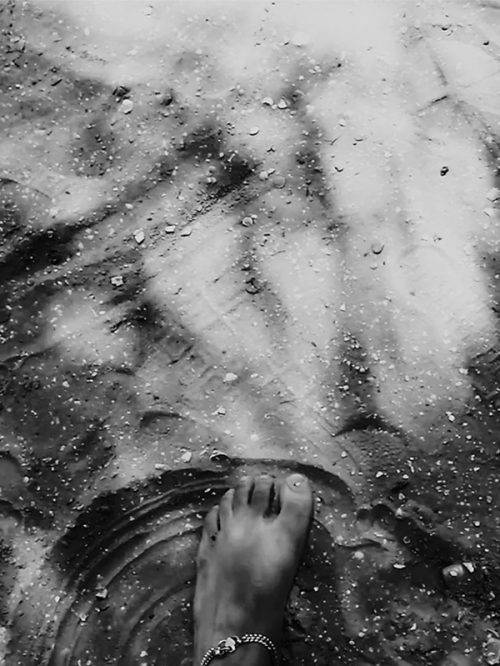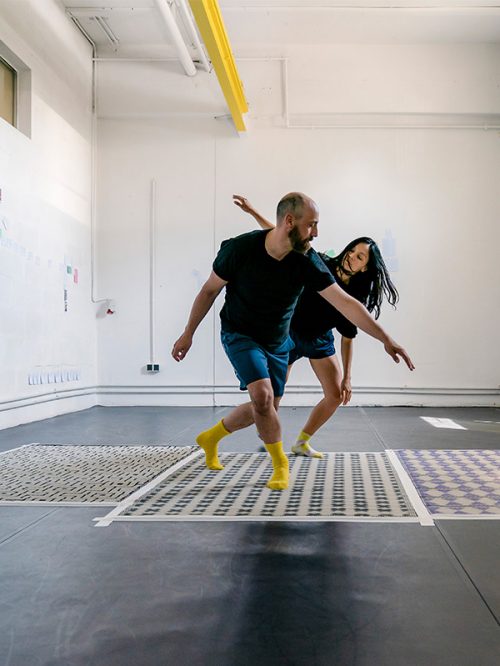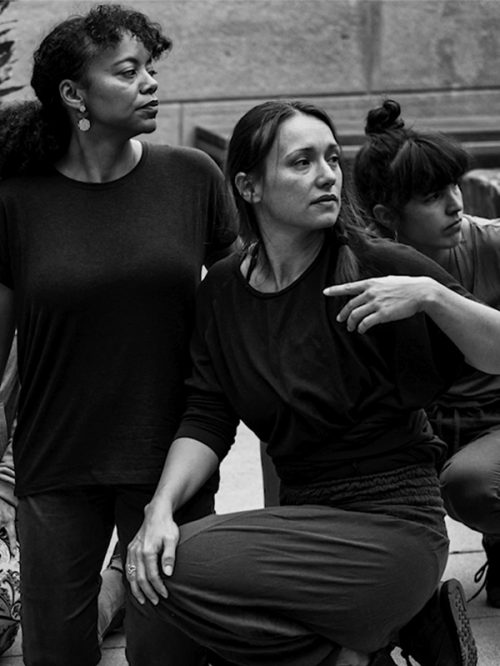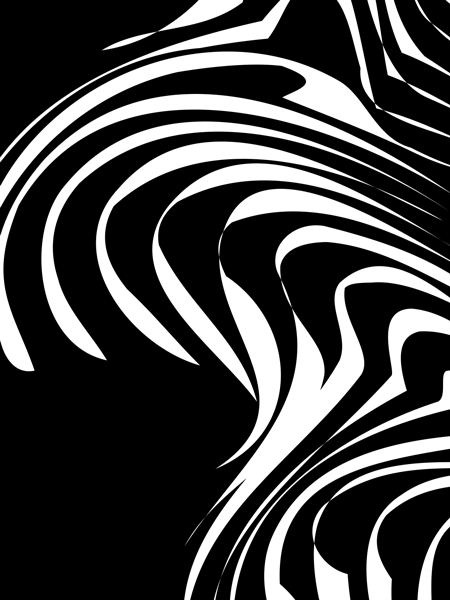RESIST_ING
Making cultural practice more resistant by moving, movements and being in motion (with each other)
I do not dance, at least not professionally. But I am “in motion” with dancing people, people from the profession of dance, dancers, choreographers, dance practitioners, artists and theorists. I like to move mentally, even if physical movement is not always easy for me. Perhaps I also seek contact with dancing people in order to dissolve this supposed binary within me. Because binary thinking and acting stands in the way of imagination and thus the creation of many different possible worlds. And isn’t it precisely the artistic field that reveals (or at least hints at) spaces of possibility and at the same time creates spaces for encounters? And what better way to come together than through dance?
This is, of course, an idealistic imagination, because dance is also a profession, whether you are a dance artist, choreographer, or in one of the many other professional areas associated with dance making. In the context of dance as cultural production, logics of exploitation inevitably creep in, for example questions of financing and tourability. So what can critical dance work look like? How can liminal spaces of (self-)critique, (self-)empowerment and gathering be created?
Being critically in motion – resisting patriarchal-capitalist interpellations
My initial thoughts for this text revolved around practices of resting. There is a broader conversation, not least because of the disastrous COVID-19 pandemic, about the exhaustion that grips many people – whether physically, psychologically, emotionally, or spiritually. The pandemic has made the precarious existence of many cultural practitioners more visible, which is why processes are now also being funded. This means that not every idea has to be immediately translated into a project and produced, but that the further development of thoughts is also considered a legitimate occupation for people in the cultural sector. Some people in this professional field were already exhausted before the pandemic, because of the care work they do for children, family, friends or allies, because of disabilities, neuro-divergences or chronic illnesses in a deeply ableist society, because of continuous experiences of racism in a white dominance society, because of, because of, because of….
I wanted to think about how people who continually experience marginalization(s), experience discrimination(s), and yet are “there,” are present, can come to rest, can rest – in this hostile environment that categorizes artistic work according to fashions and buzzwords and that doesn’t care about the conditions under which people work, with each other or in competition with each other.
I wanted to deal with the term and concept of rest, with the “otium”, leisure. In a binary world, these two poles work well together: working and being busy on the one hand – “labor”, and kind of as a reward, rest on the other. I was interested in the question of embodied productivity, that is, how through capitalist interpellations, work is almost equated with physical activity, including the act of thinking, and rest only seems possible with a complete “switching off”, “switching oneself off”, and is even seen as something that must be earned. What are the subtle workings of a patriarchal-capitalist society that inscribe themselves into our bodies, and how do they manifest in dance?
At the event “Flowers, Bells and Water – Decolonizing Turns”, which the CHAKKARs team hosted in Munich in June 2022, the urgency to examine “the big C” needed more closely was mentioned a few times. At first I thought it was about “Capitalism”, but quickly realized that people meant “Contemporary”. In a way it does fit, since the Western understanding of “contemporary” goes hand in hand with capitalist logics and practices of dominant Western societies.[1]
By now perhaps fewer people cling to the illusion that “art” is free of these economic contexts, that art is about creating, generating, and trying things out. However, all those who have to/want to make a living from their art are aware of the close connection between an aesthetic and discursive contemporaneity and the marketability of the results of artistic production.
But the fact that the concept of ‘contemporaneity’, the contemporary, is also in constant flux and necessarily dependent on the circumstances surrounding it, is usually not reflected. How can a general concept of “contemporary” be assumed in a complex and varying historico-sociocultural world? How can the contemporary be oriented towards the different lived experiences and needs of the contemporaries, or “comrades” (Genoss*innen[2]), referred to in the equi-temporal here & now? How can the narrating position (also) be centered and not only the interpreting one? And how can different narratives stand side by side and meet in a polyphonic, contradictory, complementary and encouraging coexistence?
And what about looking at other Cs that might prove to be more sustainable points of reference for a resist_ing presence and co-existence. I suggest co-operation, community and care – or even better, the practical implementations of these: co-operating, creating community, caring.
It is not easy to take up space from the margins, to move, to create one’s own movements. How can dealing with interpellations from dominant positions look like, what could be practices of resistance?
I want to share some strategic questions that help me in the process of resistance, because resist_ing is a continuous practice that sometimes works better and sometimes worse….
Situating
How am I positioned? What shapes my view of the world and the questions I am confronted with? Which (non-)knowledge do I bring into encounters with other people, things and contexts? There is no neutrality, and every gaze, every movement, every knowledge is situated. And I can set out to work out the different aspects of my situatedness in order to sharpen my gaze, but also to create transparency.
It becomes even more concrete when we talk about territorial situatedness, being located on a certain territory. For the history that has taken place there, shaped not only by migratory movements many thousands of years ago, but also by more recent history, has an impact on who moves – and how, who is allowed to move, and is no longer there on this territory. I wonder how we – moving within the borders of Germany and interwoven with its specific history, which is also the heritage of this nation state – can situate ourselves. What would a “land acknowledgement”[3] look like for a territory that caused two world wars, is responsible for several genocides and has only just begun to address its colonial crimes. Ultimately, how can I situate myself in the context of violence and violent history – what do I want to be remembered, who do I want to make visible, how can I take responsibility?
Multidimensionality
How small and simple everything seems when I have a single linear narrative. But this too is a utopian practice, a diversion that covers up the complexity of the world. How can we think in terms of interlockings, entanglements and interweavings? How can a human being be considered in all the contradictions that come with being human and being in community? How can history be thought not on an ever-evolving timeline, but as a whorl or whirl or whipped cream?
Coming together
What can coming together look like that connects people with each other? What does it take to share a space with each other? What are different formats of coming together that invite different people? What spaces can I create or what spaces do I want to be/move in? Coming together, spending time together, having fun, not feeling pressure – this is already a decolonizing practice – because nothing has to happen in the space except the fact that it is shared.
Community
Capitalism makes you lonely, high expectations of yourself make you lonely. The system that tells me I’m not good enough, that I haven’t done enough, makes me lonely – even if I’m surrounded by many people. How can I counteract this isolation? By creating unconditional community. By thinking and acting in groups and not taking myself too seriously. And still considering myself important enough to take enough space and to pay attention to my needs. Every single person counts, but none is more important than the other. How can a group become an individual, indivisible, an entity that behaves in solidarity with each other, appreciates and treats each other with respect? This is my understanding of “community”, the common thing about “communism”, and not necessarily the thing that is the same or made equal. Because in order to keep moving, the power and energy of several people is needed, like cogwheels, which start moving together and keep going.
Generosity
The focus on the individual, and what that individual “has,” whether material, immaterial, ideal, or in whatever form, is also a profoundly capitalist narrative. One of the grand narratives. That it’s all about having as much financial buffer as possible, being as secure as possible, having as much reserve as possible, etc.
How can I resist the logics of scarcity that suggests I have to constantly run the rat race? And don’t get me wrong, we ARE in the rat race, I am concerned about the speed – do we have to run? How can I shift my thinking to the logics of abundance, of plenty? How can I be generous with myself and others? How can I not herd and hoard what’s “mine” but acknowledge that everything I imagine as “mine” has always come from the sharing of others?
How can I not see the others through a colonial lens: What do I get from this person? What do I get out of being in contact with this person? But rather to have a loving interaction. And to understand that “mindfulness” falls short if I only consider myself.
And if I’m not afraid that I won’t get enough, I hopefully won’t get into the situation of wanting more and more and can also let things be.
Finding words, shaping the world
How do I speak – about myself, about my thoughts, about my artistic work, about the world, about others? How do people talk about me and my work? Language creates worlds, whether spoken, written, signed, or through another form of communication. When I question & co-create language, I can consider subtleties that can make the difference between description, judgement, and violence. How can I create my own terms, if need be, to escape appropriation by a (supposed) majority perspective?
Method-Toolbox
In my encounters with the world, there are very practical tools in my box of methods, all of which are already inherent in what I have articulated so far.
One is critical practice, the continuous questioning and scrutinizing, which, however, is also purposeful. Because aimless questioning has lost its charm for me and is just sophistry, i.e. focusing only on knowledge and not what it is for or who benefits from this knowledge. And closely connected with the questioning of the external circumstances is also self-questioning, or a loving self-criticism, so that I always leave room in myself for mistakes and fallibility, and yet do not rest on it.
For me, being-in-the-world and being-in-motion-with-others is always about how I can share space (and resources) with others, what peaceful solutions of conflicts can look like, how people can meet each other in a mutually appreciative and respectful way, and how all this is feasible in a world with limited possibilities.
All of this sounds somehow feasible, like simple practices that can help subvert the ever-present capitalist logics of exploitation of a patriarchal society. There is no outside of the system. So how can continuous resistance be implemented?
To Keep Moving.
I want to get back to resting. But not as withdrawing, switching off or anything like that. Rather: how can resting be a practice of resistance? Which aspects should be considered for that?
What do different bodies and different minds in different positions need in order to rest? What can be communally imagined practices of resting, of withdrawing oneself? How can the rest in my body become the rest in your body, or vice versa? How can I develop a diffractive approach to rest instead of a reflective one that is only about me? Because as long as resting, pausing, taking a time-out is only related to me alone, it is really only a pause, and the moment I get back into action, I press “play” again without any lasting change to this system. The desire for a break, the longing for rest and regeneration, is understandable. But the more appropriate image for this is that of a battery that is being charged so that it can discharge again while in use. Real systemic change is usually not possible, there is no framework for it – especially not if we each see ourselves as an indivisible single entity. However, if I am a part of a branching network, a nodule in the rhizome, we pull on strands at different corners and curves and thus change the structure.
That too sounds somehow simple: Just thinking about things differently. But it’s the doing that matters. Unfortunately, there is no panacea, especially in the context of systemic inequality, perpetuated systems of oppression, institutional violence, and structural exclusions that also lead to the depersonalization of responsibility and to people withdrawing from their own relationship with their fellow human beings and their environment and retreating to their role or function. There are already many attempts to resist these unjust conditions. One exciting approach is “transformative justice,” which, especially in countries and areas that were and still are colonially exploited and neoliberally governed, is not only a substitute for missing social systems, but can mean a restructuring of social relations:
“Transformative Justice (TJ) is a political framework and approach for responding to violence, harm and abuse. At its most basic, it seeks to respond to violence without creating more violence and/or engaging in harm reduction to lessen the violence. TJ can be thought of as a way of “making things right,” getting in “right relation,” or creating justice together.” [4]
The only thing that is a constant: Everything is in flux.
Therefore, I challenge us to keep moving, to dance with each other, to move something together – and if it spins fast enough, it can sometimes be as if it were standing still – a moment of rest, of letting go and letting yourself fall. Because not every movement is perceptible, and yet effective.
[1] Sandra Chatterjee from the CHAKKARs-team has already written valuable texts on these questions:
http://www.corpusweb.net/kulturelle-gleichzeitigkeit.html,
https://www.kiwit.org/kultur-oeffnet-welten/positionen/position_16768.html
[2] In German, there is a correspondence between Zeitgenössisch (Contemporary) and Genossen – schaft – i.e. comrade-ship, companion-ship, accomplice -ship – all of which are nice overlaps in content, which cannot be translated directly in English via “contemporary”, which foregrounds the temporal.
[3] “Land acknowledgements” or “territory acknowledgements” are attempts in written or spoken format to draw attention to the presence and land rights of Indigenous people on settled territory. https://native-land.ca/resources/territory-acknowledgement/
[4] At this point, I would like to refer not only to this entry, but to Mia Mingus’ entire blog, where she negotiates key issues that also concern me and generously shares her knowledge and practices:
https://leavingevidence.wordpress.com/2019/01/09/transformative-justice-a-brief-description/
Suggested Citation
Bajarchuu, Melmun. 2022. “Resist_ing“ In: Moving Interventions 2: Between Non-cooperation and Community-building Practices of Resilience in dance – through dance – because of dance, December 2022. Edited by / Herausgegeben von: Sarah Bergh and Sandra Chatterjee, with Ariadne Jacoby (CHAKKARs – Moving Interventions), translated into English by: Sandra Chatterjee. eZine published by /veröffentlicht von CHAKKARs – Moving Interventions.
About the author
Melmun Bajarchuu works at the intersections of art, theory and politics as a thinker and discourse partner, and takes on a variety of roles within collaborative artistic processes, such as critical companion, curator and production manager. She is driven by a desire for a variety of artistic forms of expression as well as to question existing structures and their accompanying power relationships and mechanisms for exclusion. She has a special interest in the interweaving of theories and practices within the context of poststructuralist, post- and decolonial as well as queer feminist perspectives. She is actively involved in the “Initiative für Solidarität am Theater” (Initiative for Solidarity in Theater) and “produktionsbande – network performing arts producers” for intersectional approaches and better working conditions in the performing arts. Since 2020, she has been working as a peer-to-peer consultant in the field of anti-discrimination at the Performing Arts Program Berlin (PAP).







